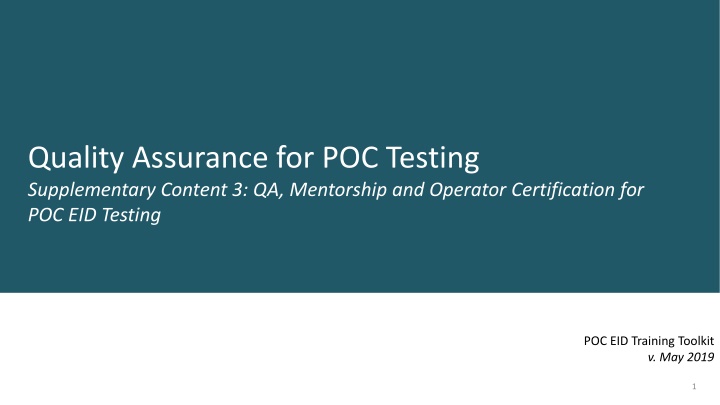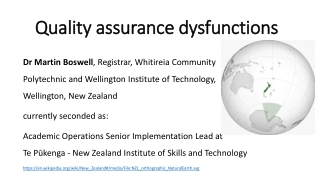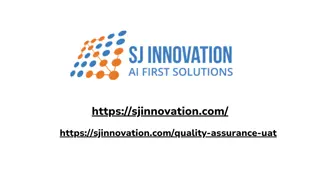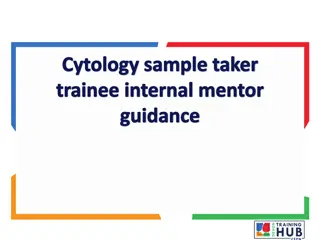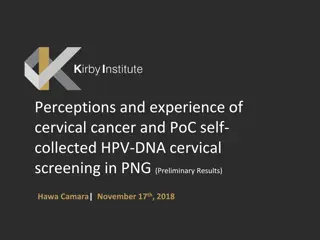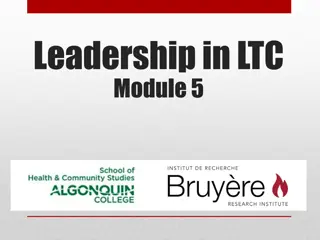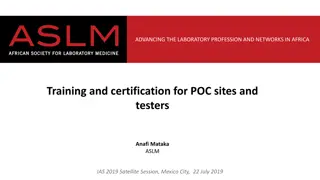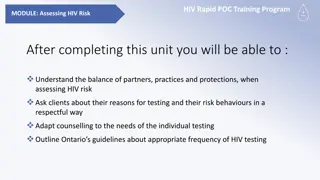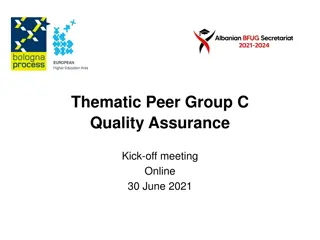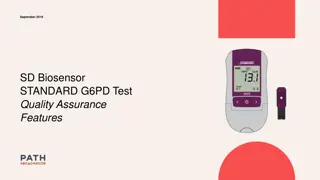Quality Assurance for Point-of-Care (POC) Testing: Mentorship and Certification Overview
This supplementary content delves into Quality Assurance (QA) frameworks, mentorship, and operator certification for POC Early Infant Diagnosis (EID) testing. Participants will grasp the country's QA framework, understand QA approaches for POC EID, learn to use checklists for facility assessment and mentorship, and explore the role of connectivity in monitoring program performance.
Download Presentation

Please find below an Image/Link to download the presentation.
The content on the website is provided AS IS for your information and personal use only. It may not be sold, licensed, or shared on other websites without obtaining consent from the author.If you encounter any issues during the download, it is possible that the publisher has removed the file from their server.
You are allowed to download the files provided on this website for personal or commercial use, subject to the condition that they are used lawfully. All files are the property of their respective owners.
The content on the website is provided AS IS for your information and personal use only. It may not be sold, licensed, or shared on other websites without obtaining consent from the author.
E N D
Presentation Transcript
Quality Assurance for POC Testing Supplementary Content 3: QA, Mentorship and Operator Certification for POC EID Testing POC EID Training Toolkit v. May 2019 1
Agenda 1 Learning Objectives 2 Quality Assurance (QA) framework and QA for EID POC Testing 3 Use of SPI -POCT checklist or equivalent to certify POC EID Sites 4 Use of supervision/mentorship checklist 5 Use of connectivity to monitor performance 6 Q&A
1 Learning Objectives At the end of this topic participants will be able to: Understand the country s QA framework Explain QA approaches for POC EID Understand and learn how to use the SPI-POCT checklist to assess facility performance Understand and learn how to use the mentorship/supervision checklist during field visits Understand how connectivity can be used to monitor program performance 3 3
Agenda 1 Learning Objectives 2 Quality Assurance (QA) framework and QA for POC EID Testing 3 Use of SPI -POCT checklist or equivalent to certify POC EID Sites 4 Use of supervision/mentorship checklist 5 Use of connectivity to monitor performance 6 Q&A
2 Why is Quality Important? Test Site Quality Accurate, Reliable Testing Quality in All Aspects of Health Care
2 The Laboratory Quality System Organization Personnel The organizational structure, responsibilities, processes, procedures, and resources for implementing quality management of the laboratory or testing site. Equipment Process ControlQC & Specimen Management Information Management Purchasing & Inventory Documents & Records Occurrence Management Assessment In other words all activities contribute to the quality of testing, directly or indirectly! Process Improvement Customer Service Facilities & Safety
2 Quality Assurance should be implemented in all phases of Testing Post-Testing Pre-Testing Patient/Client Prep Sample Collection Staff Competency Test Evaluations Reporting Data and Laboratory Management Safety Customer Service Sample Receipt and Accessioning Record Keeping Sample Transport Quality Control Testing Testing 7
Every country should have a national QA framework that applies to testing across all programs and platforms 2 [Before the start of the training, insert here a diagram of the National QA Framework] 8
Similarly, POC EID testing should follow the same QA operational framework and, at a minimum, should include these components 2 Training and Annual Competency Assessment POC EID Testing sites enrolled in EQA proficiency testing Service& Maintenance Scheme Quality Assurance for POC EID Testing Connectivity and Stock Management Internal Quality Control built into devices Mentorship/ Supervision Programs 9
Compliance with routine EQA optimizes the quality of testing and builds trust in the result from POC testing devices 2 Proposed interventions to ensure successful routine EQA 1. Central level supervisors should coordinate the External Quality Assurance exercise (e.g. National Public Health Lab) 2. Enroll POC EID sites in EQA scheme available for the country (e.g. QASI, CDC, national QAP) 3. All EQA panels should be distributed to POC sites as per EQA panel distribution SOP following the handling and transport standard requirements 4. Central level supervisors should specify with the testing lab preferred timelines for the results 5. Central level supervisors should follow up on the results from the testing sites 6. Central level supervisors should communicate performance to respective POC EID sites and conduct corrective actions when necessary. 7. To be repeated every 6 months (2 cycles per year as defined by EQA scheme provider) 10
2 If consistently done, routine EQA will provide a quality check for all POC EID testing sites What needs to be in place: Communication in advance to prepare the sites Supervisor/mentor review in advance to assess POC site performance based on data transmitted through connectivity to the POC dashboard to identify and plan for any corrective actions (if connectivity is established) Supervisor to travel to all the POC EID sites, bringing EQA-PT panels from National Reference Lab; mentorship and supervision can be done alongside EQA-PT panel delivery. Logistics for supervisor field visit 11
2 Managing discordant results at POC EID site [Before the start of the training, insert here the national policy for managing discordant EID results] 12
Agenda 1 Learning Objectives 2 Quality Assurance (QA) framework and QA for POC EID Testing 3 Use of SPI -POCT checklist or equivalent to certify POC EID Sites 4 Use of supervision/mentorship checklist 5 Use of connectivity to monitor performance 6 Q&A
The Stepwise Process for Improving the Quality of POC Testing (SPI-POCT) checklist is a simple and easy to use tool assess POCT testing quality 3 The SPI-POCT checklist assesses 9 aspects of POC testing to generate a facility score: 1. Integration of POCT service for patient care 2. Personnel training, competency and certification 3. Physical facilities 4. Safety 5. Pre-testing phase 6. Testing phase 7. Post-testing phase 8. Supplies, reagents and equipment 9. Monitoring quality Link to The SPI-POCT Checklist on the POC EID Toolkit 14
Agenda 1 Learning Objectives 2 Quality Assurance (QA) framework and QA for POC EID Testing 3 Use of SPI -POCT checklist or equivalent to certify POC EID Sites 4 Use of supervision/mentorship checklist 5 Use of connectivity to monitor performance 6 Q&A
The goal of periodic site supervision and mentorship is to identify issues early and to provide corrective and preventive actions 4 Generated from POC Database on testing & error trends or equivalent report To be used during site supervision Assessment report Carried out by trained Lab Tech/Lab coordinator using the POC supervision and mentorship checklist Every quarter or every 6 months (depends on the agreed # of cycle) Supervision Carried out by trained Lab Tech on a need basis Based on the supervision/data report findings and Test performance result Mentorship
Mentorship and supportive supervision provide opportunities for observation, assessment, reflection and joint problem solving 4 Mentorship by experienced individuals to less experienced individuals is an essential element of medical and nursing education; clinicians learn best by doing, while being supported by a more experienced colleague. Mentoring is a critical bridge for the training gap that exists between traditional didactic training and practice in the clinical setting Mentoring occurs at site level, thus ensuring that POC operators learn how to adopt SOPs and systems to their own patient population in the clinic setting Supportive supervision improves the quality of service delivery through observation, discussion and direct problem-solving, mentoring and learning from the topics that are discussed then planning the way forward with POC operators and clinic staff. Mentoring overlaps with supportive supervision whereby the testing and clinic flow is assessed and concerns are addressed through the use of collaborative problem solving 17
The POC EID Mentorship/Supervision Checklist can be used to guide site visits and identify areas for intervention and improvement 4 Suggested mentorship/supervision visit schedule: Monthly for the 1st 3 months, and then 6 monthly Lower performing sites can be visited more frequently 18
Agenda 1 Learning Objectives 2 Quality Assurance (QA) framework and QA for POC EID Testing 3 Use of SPI -POCT checklist or equivalent to certify POC EID Sites 4 Use of supervision/mentorship checklist 5 Use of connectivity to monitor performance 6 Q&A
POC devices can be monitored remotely through wireless connectivity that transmits testing data to a central server 5 5 Data is aggregated on MOH server, used for corrective action and program management Operator initiates data transmission Data transmitted through cellular network or internet connection Examples of data captured by POC devices: Error messages Error rates by facility/operator Inventory tracking Test results EQA results Testing volumes Device breakdown tracking 20
A program manager can monitor many aspects of POC testing using wirelessly transmitted testing data 5 POC Fleet Overview Testing Volume Average Result Facility- specific Error Types Error Rate Stock Management
Agenda 1 Learning Objectives 2 Quality Assurance (QA) framework and QA for POC EID Testing 3 Use of SPI -POCT checklist or equivalent to certify POC EID Sites 4 Use of supervision/mentorship checklist 5 Use of connectivity to monitor performance 6 Q&A
Questions? Thank You! 23 23
Acknowledgments The development of the POC EID Training Package was made possible thanks to Unitaid s support. Unitaid accelerates access to innovation so that critical health products can reach the people who need them.
